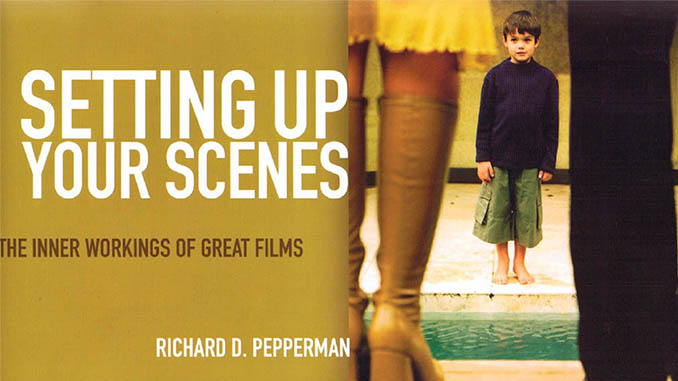
by Ray Zone
Setting Up Your Scenes
The Inner Workings of Great Films
By Richard D. Pepperman
Michael Weise Productions
245 pages, paperbound, $24.95
Motion picture editors will love this book. There are few enough books that delve deeply into the artistry and emotional impact of editing moving images but Richard Pepperman’s work definitely is one of them. Inspired by Jeremy Vineyard’s Setting Up Your Shots: Great Camera Moves Every Filmmaker Should Know, also published by Michael Wiese, Pepperman set out to write a book that illustrated his idea that filmmaking is a “backward art form” by taking a backward look at filmmaking “with the spotlight on ‘what went right.’”
A template was created for “scene studies,” with an arrangement to understand how scenes are set by way of story, characters, dialogue, scene value (text and subtext) and set-ups. Pepperman examines the “great choices” that bring them all together to produce a great scene, what he calls “the inner workings of great films.”
The selection of scenes covers six decades of filmmaking and the different category breakdowns are separated as to the human sensations of Attractions, Dangers, Delights and Exploits. With each scene, the indispensable elements of story, running time and location are set forth, along with dramatic structures in topic, inflection and beats. Characters in each scene and their activities determine the coverage of the set-ups. Pepperman guides the reader of this book into visualizing the scene in the mind’s eye and then evaluating the choices that made the scene what it was.
Under Dangers, the author examines scenes from films such as Butch Cassidy and the Sundance Kid, Dial M for Murder, The French Connection, Sophie’s Choice and Two Women. With Sophie’s Choice, Pepperman begins with the dialogue from the crucial scene in which Sophie must choose which of her children is to be taken away, the “awful scene so softly stated in the title,” as he puts it. The dialogue, beginning with flirtation and proceeding with cold logic, political discussion and “mocking nods” of the Nazi officer’s head, add up to a “devastating apprehension.”
The spinning fun ride sequence from The 400 Blows is examined with great insight. The moment of elation is quickly dashed as Antoine returns to unpleasant reality by catching sight of his mother with the other man.
In-depth examination of the shots leading up to the dialogue set the stage for the encounter between Sophie and the officer. Each shot in the sequence is shown, named and described. With this sequence the “great choice” in the filmmaking is that the flirtatiousness of the officer suggests protection for Sophie and her children. “The Officer walks away,” notes Pepperman, “but with dreadful irony, Sophie ‘encourages’ him back to her.” Pepperman makes sure the reader notes the use of close-up, understated tone and unexpected quiet in the scene. As Sophie’s daughter is carried off out of frame, her cries “play across” Sophie’s face and silent scream.
Films incorporated under Delights include Children of a Lesser God, Fanny and Alexander, The 400 Blows and The Little Fugitive. The spinning fun ride sequence from The 400 Blows is examined with great insight. The “scene value” encapsulates the young boy Antoine’s adventure skipping school which leads to the discovery of his mother with another man. The subtext is perceptive: “What is effectively a ‘freedom-filled’ fun ride echoes Antoine’s ‘swirlingly’ perplexed world.” Medium shots of Antoine spinning alternate with his point of view and at one point he has twisted himself around in position until he is upside down.
The “great choices” with this innovative ride sequence include intercutting that along with the sound of the spinning machinery and the “whooping” of other riders and spectators “makes this a ‘great ride’ for the audience.” This uninhibited production style brings a smile to Antoine and the audience. The moment of elation, this joyful break, however, is quickly dashed as Antoine returns to unpleasant reality by catching sight of his mother with the other man.
In the chapter on Attractions, Pepperman discusses films like The African Queen, The Bridge on the River Kwai, Cinema Paradiso and Tom Jones. The editing tour-de-force sequence during the meal in Tom Jones is cogently analyzed.
There are few enough books that delve deeply into the artistry and emotional impact of editing moving images but Richard Pepperman’s work definitely is one of them.
Over 400 photos from 35 classic films illustrate this book. The author characterizes his intention in the book as “going wide before going deep.” By that he means that the reader can quickly gain a good deal of skill and knowledge through reading, “and with ever-increasing experience, you can’t help but begin to go deep.” Rounding out this interesting volume are Added Attractions with assignments for discussion and a filmography. The book is written with a great passion for the artistic complexities of motion picture storytelling.
Pepperman has wide experience in the film industry as an editor. He has edited numerous documentaries and has worked on more than 1,000 commercial spots.
“I’ve always believed artists owe an appreciation to earlier generations who labored in pursuit of excellence,” he writes. “That’s one reason that I included films from much of the last century. That appreciation is given life in each new work of caring craft, creativity and integrity.”





